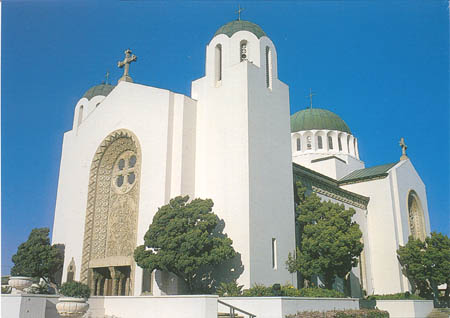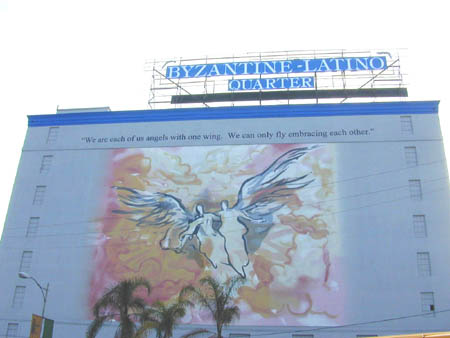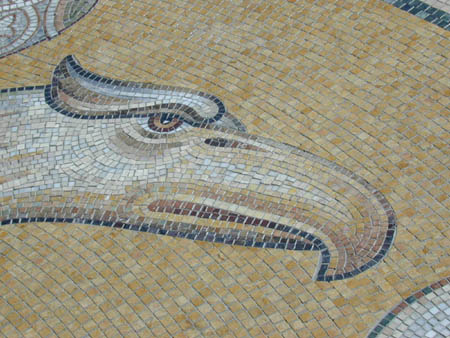

Orthodox Church Changes to Meet Needs
By Maria Fotopoulos
(LOS
ANGELES) – When
Saint Sophia Cathedral opened its doors in 1952 Los Angeles, the idea of
performing a wedding in Spanish likely would have been anathema. Fifty
years brings change.
In
L.A. at the 36th Biennial Clergy-Laity Congress of the Greek
Orthodox Archdiocese of America last summer, the Liturgy was given in
Spanish, and Orthodox children from a Tijuana, Mexico, orphanage provided
music. These inclusions added legs to the Offering-Orthodox-Faith-to-Contemporary-America
theme that the gathering was to tackle. But even before that summer event,
yes, couples wed in ceremonies conducted in Spanish at Saint Sophia.
“Churches
always change,” says Father John Bakas of Saint Sophia. “The theology
and church doctrines are the same, but the Church delivers its message in
a way that is commensurate with the realities of our times.”
As
the Greek community grew out of its early 1900s small church in downtown
L.A. on San Julian Street and into the ornate St. Sophia Cathedral,
California was growing as well. With 4.2 million people in 1950, L.A.
County added another 5.3 million by 2000 and is an unmistakable repository
of diversity – look only to L.A. schools and the more than 80 different
languages spoken in them.

And
the Normandie/Pico area where St. Sophia was built half a century ago is
now home to many from Mexico and other Latin American countries. But the
Byzantine/Renaissance-influenced cathedral still draws its predominantly
Greek congregation of as many as 1,000 from perhaps a 60-mile radius –
from throughout L.A. County, as well as an adjacent county to the south.
Los Angeles’ Greek community has never been centralized, as in cities
such as New York City and Chicago.
“It’s
a broad area, because it was never intended to be a local neighborhood
church; it was intended to be a diocesan cathedral drawing people from all
over,” says Bakas.
But
Greek Orthodox doesn’t mean Greek-only, and perhaps 20 percent of the
congregation is not. “Contemporary America is a multiethnic,
multi-religious, multilingual society,” Bakas says. As the majority of
the area’s neighbors are Spanish speakers, he adds, “The Orthodox
faith has to be offered in the languages of the people.” Thus, step into
this Greek Orthodox church and you might hear a wedding, sermon or baptism
delivered in Spanish.
What
is now called the Byzantine-Latino Quarter is a dramatically changed
landscape from the late 1940s when Hollywood mogul and St. Sophia’s
patron, Charles Skouras, began envisioning a new church for L.A.’s Greek
community. Besides more ethnically diverse now, the immediate environs of
the church are poorer.
Sophia
in Greek means wisdom and Skouras perhaps showed this in choosing
the church location. “To Mr. Skouras’ credit, I think it’s
inspired,” says Bakas. “A lighthouse is built on rocky shores, and the
Church should be a lighthouse on the rocky shore which is this part of
town.”
Simply
by way of its location, according to Bakas, St. Sophia reaches out to its
neighbors, not to proselytize, but to serve. “Service is very important
in the Church,” Bakas says. An example is the church-sponsored Camp
Axios, a values, ethics and character-building camping experience for
at-risk, inner city kids who are close to criminal activity, drugs and
gangs.
Bakas
believes in the power of the members of the church to become involved to
generate change in the immediate community too. “I think the Church has
a role to play,” he says. “Cathedrals – Notre Dame, Westminster
Abbey – always have been the generating engines of great cities.”

The
1997 creation of the Byzantine-Latino Quarter, a cultural, economic and
historic redevelopment zone, may in the long-term urge revitalization
around St. Sophia. “Los Angeles in the next 10 years is going to have a
major renewal,” Bakas believes. “Frankly, people just can’t move any
farther out; you just can’t have a quality of life and drive two hours
to work and two hours back home.”
As
one of the fastest growing areas in the United States, with 782 people
moving in everyday in 2001, Bakas’ thinking may be prescient. Hopeful
homeowners may start to reexamine the inner city and environs and begin a
rehabbing renaissance, some of which already is occurring in the heart of
Downtown L.A., only minutes away from the Quarter.
“I’m
very encouraged,” Bakas says. “The better years of St. Sophia
Cathedral are in the future.”
Sidebar:
St. Sophia’s
Hollywood Heritage
From
time-to-time, a wedding planner calls Saint Sophia Cathedral in Los
Angeles asking how to have a Greek wedding, clearly a vestige of the
movie, My Big Fat Greek Wedding.
Although
this bumping up against “Hollywood” may be a short-lived phenomenon,
St. Sophia is steeped in a longer-lived Hollywood legacy.
As
the story is told, Charles Skouras, a Greek immigrant of humble
beginnings, vowed to build a cathedral if he “made it” in Hollywood.
Indeed, he – and brothers Spyros and George – all ended up “feeling
the love.” Their combined credits include major roles in 20th Century
Fox and United Artists, along with the making of Cleopatra and the
development of CinemaScope. They also had a hand in creating
Century City and managed a 500-theatre movie chain.
The
success in the new world brought the old world to Los Angeles in a big way
when Skouras made good on his vow and commenced with plans to build a
cathedral, which was big news throughout the Greek community in the United
States.
Inspired
by the original St. Sophia of Constantinople, plans included seating for
2,000. The cruciform design eventually was scaled back, but that made
little impact on the resulting impressive edifice. The interior is light,
mirroring Orthodox thinking that says the interior of the human being
should be “light.”
The
church immediately engages all five senses, starting with the smells of
burning incense and moving on to an extraordinary visual display. With
leaded glass from Belgium, England and Germany; marble from Greece and
Italy; 17 over-the-top chandeliers from Czechoslovakia, three of which
each weigh a ton; 25,000 pounds of copper on the roof; religious
depictions everywhere; a dome rising 90 feet into the air and lots of
24-carat gold leaf; St. Sophia is a very visible symbol of Orthodox faith
and a translation of Skouras’ belief in service. Built for approximately
$2 million between 1948 and 1952, if built today, costs would exceed $50
million.
St.
Sophia also was built to last a long time. Constructed with seismic
considerations given California’s earthquake propensities, the
church’s steel girders and reinforced concrete go 20 feet into the
ground and its transepts support 440 tons.
Skouras’
Hollywood flair came through in theatrical ways. A lighting panel was
included at Skouras’ pew allowing him to “influence” the look and
feel of the “stage.” And, the ten angels around the dome actually are
baby pictures of the children and grandchildren of benefactors, often
referred to as “Charlie’s Angeles.”

Beyond
the calls for big fat Greek weddings, Hollywood and celebrity still touch
St. Sophia. Arianna Huffington, syndicated columnist and talk-show
regular; Michael Huffington, former politician, sometime filmmaker and
multimillionaire; and actors Tom Hanks and Rita Williams may be seen at
church services. But, as St. Sophia’s Father John Bakas is quick to
share, “When a person kneels in a pew, that star of the stage and silver
screen is no more valuable in God’s eye than the 80-year-old widow
living on Social Security.”
For
information on St. Sophia tours and services, visit stsophia.org.
Maria
Fotopoulos is an independent marketing communications consultant in Los
Angeles and the founder of TurboDog Communications. Prior to forming
TurboDog, Fotopoulos spent eight years with Nissan North America, Inc. in
a variety of communications and writing positions. A graduate of the
University of Oklahoma where she majored in journalism, Fotopoulos has
written for the El Paso Times, Oklahoma Gazette, Daily
Oklahoman and Fairpress (Connecticut).